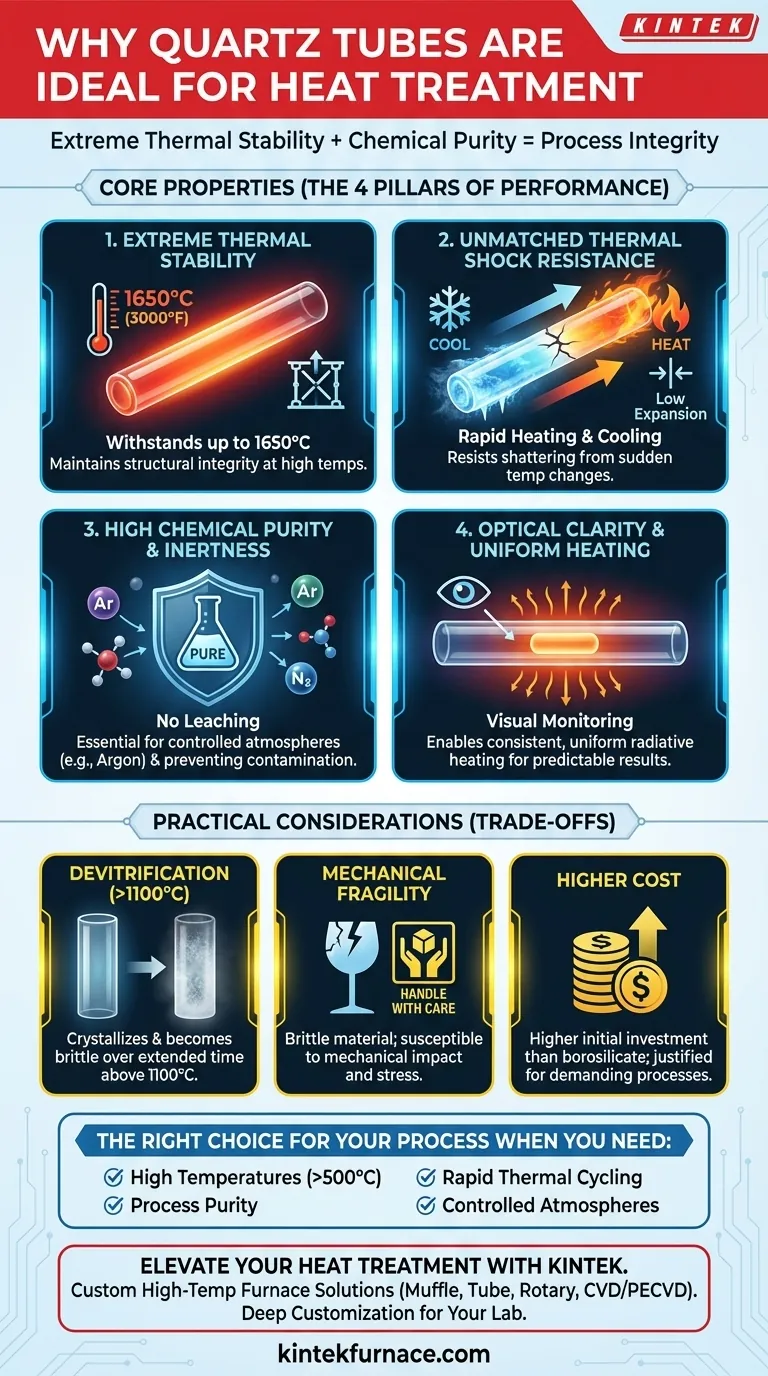In short, quartz is the material of choice for high-temperature applications due to its unique and powerful combination of properties. It possesses extreme thermal stability, very low thermal expansion, high chemical purity, and optical clarity, making it uniquely suited to contain and protect materials during demanding heat treatment processes.
The true value of quartz is not a single property, but its ability to simultaneously withstand extreme heat changes and maintain a chemically pure environment. This combination ensures the integrity of the material being processed, which is the primary goal of any heat treatment.
The Core Properties of Quartz for Heat Treatment
To understand why quartz is the industry standard for furnace tubes and similar apparatus, we must examine how its specific characteristics solve critical engineering challenges.
Extreme Thermal Stability
Quartz, specifically fused quartz, has an exceptionally high softening point, typically around 1650°C (3000°F).
This allows it to remain structurally sound at the high temperatures required for processes like annealing, diffusion, and sintering, where lesser materials like borosilicate glass would deform or melt.
Unmatched Thermal Shock Resistance
This is arguably its most critical property. Quartz has an extremely low coefficient of thermal expansion.
In practical terms, this means the material does not expand or contract much when its temperature changes. This allows a quartz tube to be heated to over 1000°C and then rapidly cooled without cracking or shattering—a phenomenon known as thermal shock.
High Chemical Purity and Inertness
Quartz tubes are manufactured to high purity standards. They will not leach contaminants into the sample, even at extreme temperatures.
This chemical inertness is vital. Many heat treatments occur in a controlled atmosphere, such as with argon gas, to prevent oxidation. The quartz tube provides a chemically stable vessel that contains this atmosphere and does not react with the sample or the protective gas.
Optical Clarity and Uniform Heating
The transparency of quartz to a wide spectrum of light, including infrared, allows for two key benefits.
First, it enables visual monitoring of the process. Second, and more importantly, it allows for uniform radiative heating of the sample inside, ensuring consistent and predictable results.
Understanding the Practical Limitations
While ideal, quartz is not without its trade-offs. Acknowledging these limitations is key to using it effectively and safely.
Devitrification at Sustained High Temperatures
When held at very high temperatures (typically above 1100°C) for extended periods, quartz can begin to devitrify.
This process causes the amorphous glass structure to crystallize, turning it opaque and making it more brittle. This is a primary factor limiting the operational lifespan of a quartz furnace tube.
Mechanical Fragility
Like any glass, quartz is brittle and susceptible to mechanical shock. It must be handled with care to avoid scratches or impacts that can create stress points and lead to failure under thermal load.
Cost Considerations
Quartz is significantly more expensive than other types of laboratory glass, such as borosilicate. Its use is justified when the process demands high temperatures, high purity, or excellent thermal shock resistance that other materials cannot provide.
Making the Right Choice for Your Process
Your specific application determines whether quartz is not just the best choice, but the only choice.
- If your primary focus is process purity and high temperatures (>500°C): Quartz is the non-negotiable standard for preventing contamination and ensuring structural integrity.
- If your primary focus is rapid heating and cooling cycles: The low thermal expansion of quartz makes it the only reliable option to prevent failure from thermal shock.
- If your primary focus is preventing oxidation: The impermeability and chemical inertness of a quartz tube are essential for maintaining a pure, controlled atmosphere (like argon) around your sample.
Ultimately, choosing quartz is an investment in process stability, purity, and repeatability.
Summary Table:
| Property | Key Benefit for Heat Treatment |
|---|---|
| Extreme Thermal Stability | Withstands temperatures up to 1650°C without deformation |
| Low Thermal Expansion | Resists cracking from rapid heating and cooling cycles |
| High Chemical Purity | Prevents contamination in controlled atmospheres like argon |
| Optical Clarity | Enables visual monitoring and uniform radiative heating |
| Devitrification Limitation | Crystallizes above 1100°C, reducing lifespan if not managed |
Elevate your heat treatment processes with KINTEK's advanced high-temperature furnace solutions. Leveraging exceptional R&D and in-house manufacturing, we provide diverse laboratories with custom quartz tube systems, including Muffle, Tube, Rotary Furnaces, Vacuum & Atmosphere Furnaces, and CVD/PECVD Systems. Our strong deep customization capability ensures precise alignment with your unique experimental needs, enhancing purity, stability, and efficiency. Contact us today to discuss how we can support your specific requirements!
Visual Guide

Related Products
- Laboratory Quartz Tube Furnace RTP Heating Tubular Furnace
- High Pressure Laboratory Vacuum Tube Furnace Quartz Tubular Furnace
- 1700℃ High Temperature Laboratory Tube Furnace with Quartz or Alumina Tube
- 1400℃ High Temperature Laboratory Tube Furnace with Quartz and Alumina Tube
- Multi Zone Laboratory Quartz Tube Furnace Tubular Furnace
People Also Ask
- What is a Quartz Tube Furnace and what is its primary function? Essential for Real-Time Material Observation
- What is the use of a quartz tube furnace? For High-Purity, Observable Material Processing
- How does the work process of a quartz tube furnace typically proceed? Master Precision Heating for Advanced Materials
- How does the quartz tube furnace minimize heat loss? Double Insulation for Energy Efficiency
- How does sample handling differ between vertical and horizontal tube furnaces? Choose the Right Furnace for Your Lab



















